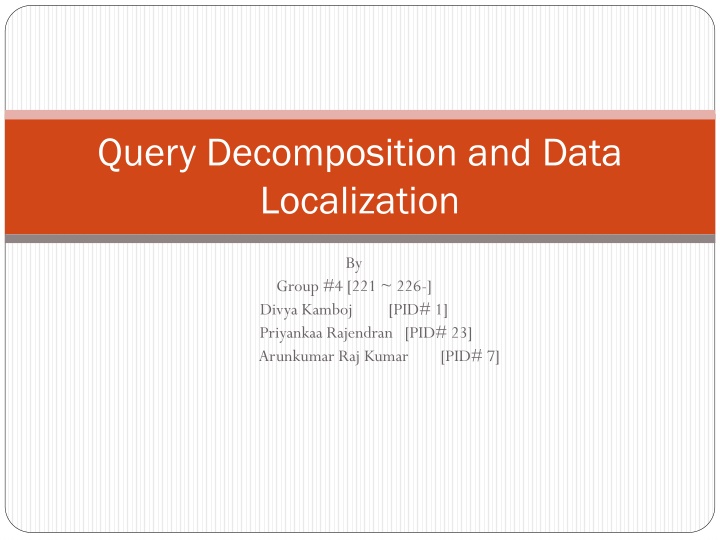
Understanding Query Decomposition and Data Localization
Explore the process of query decomposition and data localization in databases, covering normalization, analysis, and the importance of transforming queries for efficient processing. Learn about disjunctive and conjunctive normal forms and how query analysis helps ensure query correctness.
Download Presentation

Please find below an Image/Link to download the presentation.
The content on the website is provided AS IS for your information and personal use only. It may not be sold, licensed, or shared on other websites without obtaining consent from the author. If you encounter any issues during the download, it is possible that the publisher has removed the file from their server.
You are allowed to download the files provided on this website for personal or commercial use, subject to the condition that they are used lawfully. All files are the property of their respective owners.
The content on the website is provided AS IS for your information and personal use only. It may not be sold, licensed, or shared on other websites without obtaining consent from the author.
E N D
Presentation Transcript
Query Decomposition and Data Localization By Group #4 [221 ~ 226-] Divya Kamboj [PID# 1] Priyankaa Rajendran [PID# 23] Arunkumar Raj Kumar [PID# 7]
Outline 1. Query Decomposition Normalization Analysis 2. Join Graph
7.1 Query Decomposition Query decomposition maps a distributed calculus query into an algebraic query on global relations Query decomposition is the first phase of query processing that transforms a relational calculus query into a relational algebra query. The successive steps of query decomposition are (1) normalization, (2) analysis, (3) elimination of redundancy, and (4) rewriting
7.1.1 Normalization The input query may be arbitrarily complex, depending on the facilities provided by the language. It is the goal of normalization to transform the query to a normalized form to facilitate further processing There are two possible normal forms for the predicate, one giving precedence to the AND ( ) and the other to the OR ( ).
In the disjunctive normal form, the query can be processed as independent conjunctive subqueries linked by unions (corresponding to the disjunctions). However, this form may lead to replicated join and select predicates, as shown in the following example. The conjunctive normal form is more practical since query qualifications typically include more AND than OR predicates. However, it leads to predicate replication for queries involving many disjunctions and few conjunctions, a rare case
The conjunctive normal form is a conjunction ( predicate) of disjunctions ( predicates) as follows:
7.1.2 Analysis Query analysis enables rejection of normalized queries for which further processing is either impossible or unnecessary. The main reasons for rejection are that the query is type incorrect or semantically incorrect. When one of these cases is detected, the query is simply returned to the user with an explanation. Otherwise, query processing is continued.
Techniques to detect incorrect queries A query is type incorrect if any of its attribute or relation names are not defined in the global schema, or if operations are being applied to attributes of the wrong type. The technique used to detect type incorrect queries is similar to type checking for programming languages. However, the type declarations are part of the global schema rather than of the query, since a relational query does not produce new types.
Example 7.2 The following SQL query on the engineering database is type incorrect for two reasons. First, attribute E# is not declared in the schema. Second, the operation >200 is incompatible with the type string of ENAME. SELECT E# FROM EMP WHERE ENAME > 200 A query is semantically incorrect if its components do not contribute in any way to the generation of the result. In the context of relational calculus, it is not possible to determine the semantic correctness of general queries. However, it is possible to do so for a large class of relational queries, those which do not contain disjunction and negation. This is based on the representation of the query as a graph, called a query graph or connection graph
Join Graph An important subgraph of the query graph is the join graph, in which only the joins are considered. The join graph is particularly useful in the query optimization phase. The query graph is useful to determine the semantic correctness of a conjunctive multivariable query without negation. Such a query is semantically incorrect if its query graph is not connected. In this case one or more subgraphs (corresponding to subqueries) are disconnected from the graph that contains the result relation. The query could be considered correct (which some systems do) by considering the missing connection as a Cartesian product
Example 7.3 Find the names and responsibilities of programmers who have been working on the CAD/CAM project for more than 3 years. The query expressed in SQL is SELECT ENAME, RESP FROM EMP, ASG, PROJ WHERE EMP.ENO = ASG.ENO AND ASG.PNO = PROJ.PNO AND PNAME = "CAD/CAM" AND DUR 36 AND TITLE = "Programmer"
The query graph for the query in example 7.3 is shown below:
Example 7.4 Let us consider the following SQL query: SELECT ENAME, RESP FROM EMP, ASG, PROJ WHERE EMP.ENO = ASG.ENO AND PNAME = "CAD/CAM" AND DUR 36 AND TITLE = "Programmer"
Continued.. Its query graph, shown in Figure 7.2, is disconnected, which tells us that the query is semantically incorrect. There are basically three solutions to the problem: (1) reject the query, (2) assume that there is an implicit Cartesian product between relations ASG and PROJ, or (3) infer (using the schema) the missing join predicate ASG.PNO = PROJ.PNO which transforms the query into that of Example 7.3.
